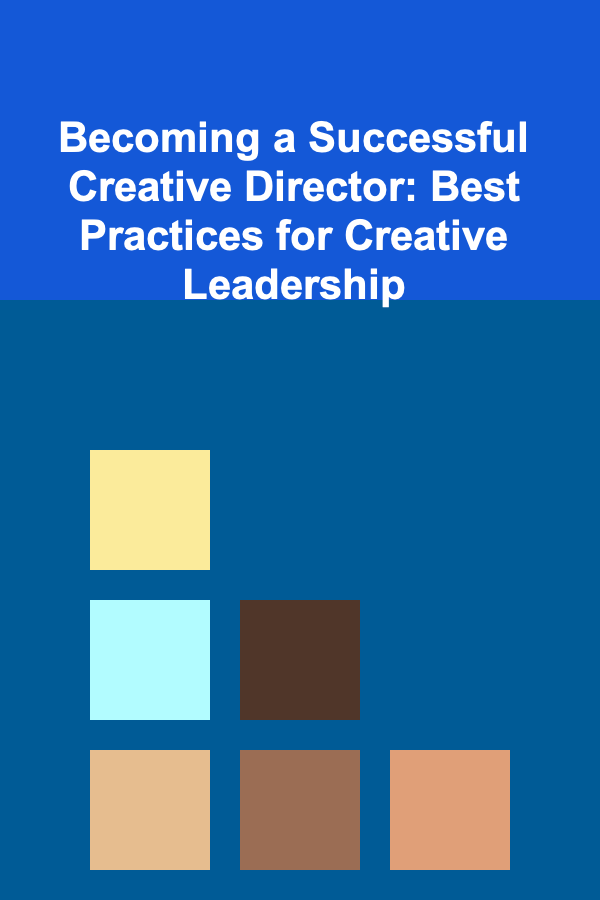
Becoming a Successful Creative Director: Best Practices for Creative Leadership
ebook include PDF & Audio bundle (Micro Guide)
$12.99$11.99
Limited Time Offer! Order within the next:

The role of a Creative Director is often seen as the pinnacle of a creative career, combining artistic vision, strategic insight, and leadership skills to shape the direction of a brand or project. A successful Creative Director is not just someone with a sharp design eye but a leader who can inspire, guide, and cultivate creativity within a team, while aligning all creative outputs with the company's overarching goals.
In this actionable guide, we'll explore the best practices for becoming a successful Creative Director. From building effective teams to mastering communication skills, here are the critical areas that will help you thrive in your leadership role.
Define Your Leadership Philosophy
As a Creative Director, you're not only responsible for guiding your team's creative direction but also for fostering a positive work environment. Your leadership style has a significant impact on the success of your team, and it's essential to define your leadership philosophy early on.
Actionable Steps:
- Be Transparent and Approachable: Transparency fosters trust, while approachability encourages open communication. Keep your team informed about the company's goals, deadlines, and expectations.
- Empower, Don't Micromanage: Trust in the abilities of your team. Encourage autonomy and give creative freedom, but ensure there are clear expectations and deadlines. Micromanagement stifles creativity and can lead to dissatisfaction.
- Lead by Example: Show your team what you expect from them through your actions. Whether it's delivering on deadlines, approaching challenges with a positive attitude, or remaining open to feedback, being a role model is crucial to establishing credibility as a leader.
Understand and Articulate the Brand Vision
A creative director is the custodian of the brand's vision and voice. Every creative decision you make should align with the company's mission, values, and goals. Your ability to understand and articulate the brand vision is crucial to driving cohesive and consistent creative output across all projects.
Actionable Steps:
- Dive Deep into the Brand's Purpose: Take the time to understand the brand's history, purpose, values, and target audience. This understanding will help you craft strategies and visual identities that resonate with the intended audience.
- Collaborate with Other Departments: Work closely with marketing, product, and business teams to ensure that creative work supports broader organizational goals. This collaborative approach will help align creative outputs with business objectives.
- Regularly Revisit the Brand Vision: The market evolves, and so should your brand. Regularly revisit and refine your brand's vision to stay relevant while maintaining consistency. Keep your team informed about any changes in direction to ensure they remain aligned.
Develop Strong Communication Skills
Effective communication is one of the most essential skills for any creative leader. As a Creative Director, you'll need to convey your ideas clearly to your team, clients, and other stakeholders. You must also be able to listen carefully to feedback and foster constructive discussions.
Actionable Steps:
- Communicate Your Vision Clearly: When presenting creative ideas or concepts, make sure that the team understands the purpose behind the work. Communicate the rationale behind design choices and how they tie into the broader strategy or brand identity.
- Listen Actively: Your team and stakeholders will often have valuable input. Be open to feedback and listen with the intent to understand, not just to respond. Active listening fosters a culture of collaboration and continuous improvement.
- Encourage Open Feedback: Make your team feel comfortable providing feedback and sharing ideas. Regular feedback sessions not only improve the work but also help team members feel valued and heard.
Build and Cultivate a Creative Team
One of the most critical aspects of a successful Creative Director's role is building a high-performing creative team. The best creative directors understand that the strength of their work lies in the strength of their team. A diverse group of talented individuals brings different perspectives, ideas, and skills to the table, all of which contribute to richer and more innovative output.
Actionable Steps:
- Hire for Fit and Skill: When assembling your team, focus not only on technical expertise but also on cultural fit. A creative team that works well together, shares similar values, and complements each other's strengths will be more productive and innovative.
- Foster a Growth Mindset: Encourage continuous learning and professional development. Provide resources, workshops, and opportunities for your team to expand their skill set, whether through formal training or hands-on experience.
- Create a Safe Space for Creativity: Ensure your team feels safe to express ideas, take risks, and fail without judgment. An environment that supports creative experimentation leads to more innovative and bold outcomes.
Balance Creativity with Practicality
While creativity is at the core of your role, you must also ensure that creative ideas are practical and achievable within the constraints of time, budget, and resources. A successful Creative Director knows how to strike a balance between innovation and practicality.
Actionable Steps:
- Understand the Limitations: Before embarking on a project, understand the limitations---whether it's a budget, timeline, or technical constraints. Having a clear understanding of the resources available helps you plan and execute your ideas more effectively.
- Provide Clear Guidelines for Execution: Creative freedom is essential, but the implementation of ideas needs structure. Set clear guidelines and timelines to keep projects on track while ensuring that creative integrity is maintained.
- Be Solution-Oriented: Sometimes, the best creative ideas come with challenges. Be prepared to offer practical solutions when obstacles arise. Whether it's a shift in the budget or changes to the project scope, approach the situation with flexibility and optimism.
Inspire and Motivate Your Team
As a Creative Director, you are responsible for keeping your team motivated and inspired. Creative work can be demanding, and your ability to energize your team, even during challenging times, is critical for long-term success.
Actionable Steps:
- Celebrate Successes: Take the time to celebrate your team's wins, both big and small. Recognizing hard work and achievements motivates your team and reinforces the value of their contributions.
- Foster Intrinsic Motivation: Encourage passion and enthusiasm for the creative process. When team members are intrinsically motivated, they perform at their best and take ownership of their work.
- Provide Constructive Feedback: While praise is important, constructive feedback is equally crucial for growth. Give feedback in a way that helps your team improve without discouraging them. Focus on the work and the process rather than the individual, and always provide actionable suggestions for improvement.
Stay Updated on Industry Trends
The creative landscape is constantly evolving. As a Creative Director, you need to stay on top of emerging trends, tools, and technologies to ensure your team is using the best available resources and keeping their work fresh and relevant.
Actionable Steps:
- Invest in Continuing Education: Attend industry conferences, workshops, and webinars to learn from peers and stay updated on the latest trends. Additionally, consider subscribing to industry publications or joining online communities where you can engage with other professionals.
- Experiment with New Tools and Techniques: Encourage your team to experiment with new design tools, software, and techniques. Whether it's a new rendering tool or a new social media platform, staying current with new technologies helps you stay competitive.
- Analyze Competitors and Inspiration Sources: Study your competitors and other creative leaders. Look for innovative campaigns, designs, or content that inspire you and your team. But remember, inspiration should lead to innovation---not imitation.
Master Time Management and Prioritization
Creative projects are often complex, with multiple stakeholders, tight deadlines, and shifting priorities. As a Creative Director, you need to manage your time effectively while ensuring that the team remains focused on the highest-priority tasks.
Actionable Steps:
- Use Project Management Tools : Tools like Asana, Trello, or Monday.com help track deadlines, assign tasks, and monitor progress. Implementing a clear project management system ensures that everyone stays on the same page.
- Prioritize Tasks Based on Impact: When juggling multiple projects, prioritize tasks that have the most significant impact on your business or brand. Delegate tasks based on the expertise and strengths of your team members.
- Know When to Say No: As a leader, you'll often face demands that conflict with your team's current priorities. Learn to say no or push back when necessary to protect your team's time and focus.
Conclusion
Becoming a successful Creative Director requires a combination of creative expertise, strong leadership skills, and the ability to balance art with practicality. It's about more than just making beautiful things---it's about guiding a team, communicating a brand's vision, and driving the creative process to meet business objectives.
By embracing these best practices and continually refining your leadership approach, you can excel as a Creative Director, inspire your team, and produce creative work that not only pushes boundaries but also drives meaningful results.
Reading More From Our Other Websites
- [Personal Financial Planning 101] How to Save Money on Groceries with a Strategic Plan
- [Paragliding Tip 101] Emergency Landings: Quick Decision-Making When Things Go Wrong
- [Tiny Home Living Tip 101] Best Storage Solutions Under Stairs in Tiny House Designs
- [Toy Making Tip 101] DIY Playtime: Step‑by‑Step Guides to Building Kids' Toys from Reclaimed Items
- [Home Pet Care 101] How to Deal with Pet Stains and Odors: A Comprehensive Guide
- [Home Storage Solution 101] How to Use Under-Bed Storage to Declutter Your Bedroom
- [Organization Tip 101] How to Organize Your Digital Music Library for Easy Listening
- [Organization Tip 101] How to Budget for Irregular Income Fluctuations
- [Home Lighting 101] How to Use String Lights to Add Whimsy and Warmth to Your Home
- [Home Family Activity 101] How to Organize a Family Talent Show Night at Home

Building a Support System During Your Job Search: An Actionable Guide
Read More
How to Create a Cozy Reading Nook with Organized Books
Read More
How To Cultivate Self-Awareness Through Stoic Reflection
Read More
How to Declutter Your Living Room and Keep It Organized
Read More
How to Organize Electronics and Cables Without the Clutter
Read More
How to Use a Meal Planning Calendar Effectively
Read MoreOther Products

Building a Support System During Your Job Search: An Actionable Guide
Read More
How to Create a Cozy Reading Nook with Organized Books
Read More
How To Cultivate Self-Awareness Through Stoic Reflection
Read More
How to Declutter Your Living Room and Keep It Organized
Read More
How to Organize Electronics and Cables Without the Clutter
Read More